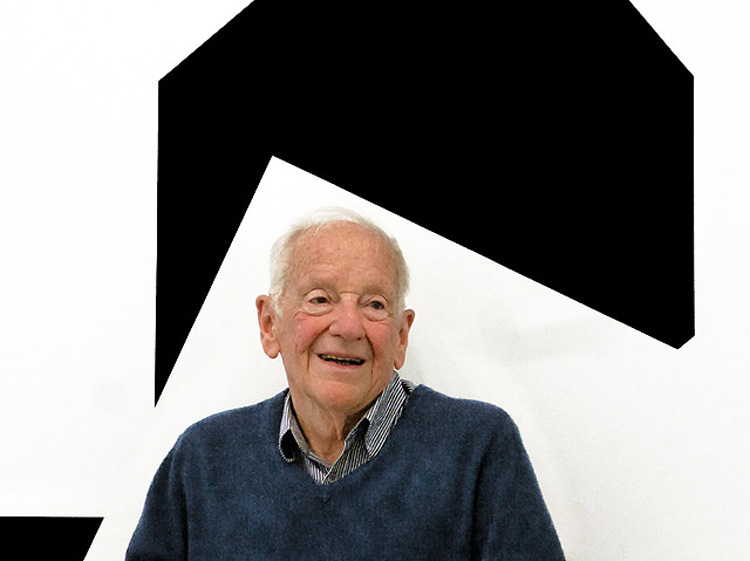
François Morellet in his studio, Cholet. Courtesy The Mayor Gallery, London.
Interview and translation by ANGERIA RIGAMONTI di CUTÒ
François Morellet initially came to prominence as a founder of the influential postwar art collective Groupe de Recherche d’Art Visuel (GRAV). Over the arc of his enduring career, he has produced works in a variety of media including painting, sculpture and neon, as well as site-specific installations, always with the intent of “doing as little as possible”. A self-taught precursor of minimalism, kinetic, programmed, and light art, Morellet’s systems are produced through a combination of chance and a series of constraints, both real and self-imposed. For all his insistence on rational, geometric schemes and aversion for “personality”, Morellet infuses his works and writings with an unusual levity as emerges in his delight in wordplay that restores a madcap Dada absurdity to the prevailing high seriousness of the art world.
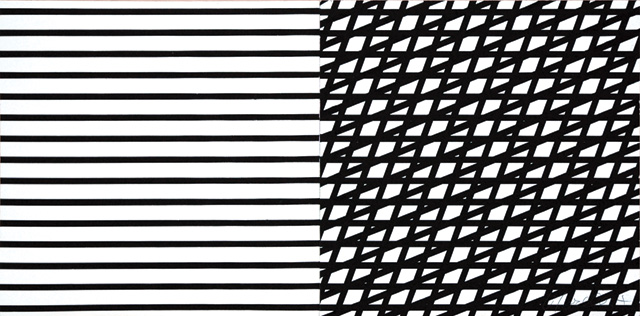
François Morellet. 0° - 110° - 157°5, 1972. Silkscreen ink on vinyl paint on paper on MDF, two parts, 30 x 30 cm. Courtesy The Mayor Gallery, London.
Angeria Rigamonti di Cutò: Your father was an industrialist, but yours was a household that was very receptive to different kinds of artistic forms. Many artists encounter opposition from their parents but this doesn’t seem to have been the case with you?
François Morellet: My father, Charles Morellet, despite his career as a high-ranking civil servant (he was a prefect) and, later, an industrialist, felt a great affinity with artists, writers, musicians and painters and liked being permanently surrounded by them. A self-published author and a virtuoso of language and humour, my father overestimated the status of artists and the prestige of celebrity, something that certainly influenced me and led me to take this path.
ARC: You yourself were an industrialist for around 30 years. How did you experience this double identity of artist (if you accept the term) and industrialist? In an orthodox vision, the two roles might seem oppositional, though I suspect this might not be the case for you?
FM: I would say that this double life was a piece of luck that allowed me to develop with complete freedom, away from art schools and professors whom I always detested. It also gave me financial independence that allowed me to produce and keep a large number of works until I was 50 when I was finally able to begin living on my art alone.
ARC: Your largely autodidactic formation saw you educate yourself not at the institutions of high art, of which France was a centre par excellence, but rather at the Musée de l’Homme. This roused your interest in Oceanic tapa paintings, and you also were affected by the abstract forms of Islamic art you saw in Granada. What did these other art forms give you – was it their all-over geometric abstraction?
FM: Yes, my aversion for school and teachers put me off everything that was traditionally taught, including a visit to the Louvre with my class at the Lycée Charlemagne. The Musée de l’Homme was deserted, exhibiting what at the time was considered “minor” or folk art. In 1950, the Alhambra too was underestimated and little-frequented. The repetitive patterns of Oceanic tapas and the positive/negative forms and all-over, geometric, linear interlacing of Islamic art were truly an emotional shock, a kind of “revelation”.
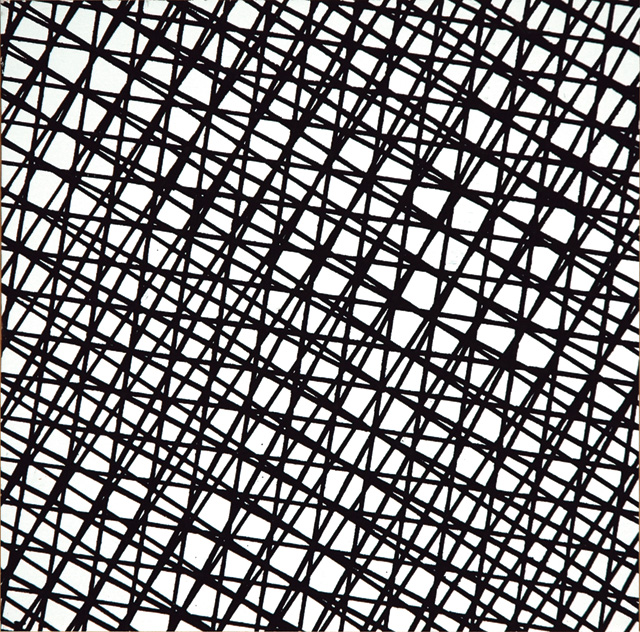
François Morellet. 10° - 100°, 27° - 117°, 32° - 122°, 1969. Silkscreen printing on vinyl paint on cardboard on MDF, 22.5 x 22.5 cm. Courtesy The Mayor Gallery, London.
ARC: You went to Brazil for an extended period at the outbreak of the Korean war. There you had an important encounter with Almir Mavignier, who introduced you, via reproductions, to Max Bill. It’s interesting that you were introduced to aspects of European modernism through a South American filter – though presumably you were already aware of van Doesburg and Mondrian. What was the impact of Brazil on your development?
FM: In actual fact, my stays in Brazil only amounted to a month and a half in 1950 and two months in 1951. Although I adored the country, particularly the joie de vivre and nonchalance of Brazilian men and women, it was above all my friendship with Almir Mavignier that was decisive, thanks to the friendly network of European artists he rapidly developed after emigrating to France and later to Germany. Amongst these were Ellsworth Kelly in Paris, Max Bill, director of the celebrated Ulm School of Design, as well as Josef Albers who taught there.
Since I was stuck in Cholet because of my profession, the encounters and friendships I was lucky enough to experience in the 50s thanks to Mavignier encouraged me in my choices and in the direction of my work. I remember my amazement on suddenly being awarded the Will Grohmann Prize in Berlin, something that had been secretly orchestrated by Bill. I can still hear the great voice of [Richard] Lohse, saying to me with rolled Rs: “Morellet, stay hard!” [a reference to hard-edge painting].
ARC: It’s a commonplace that many artists of the New Tendenciesrejected the “expressive” lyrical abstraction of the 50s. You recount an amusing recurring nightmare you had in the 50s, at the height of Action Painting and Art Informel, in which, to your horror, you would produce picture after picture “swimming in the syrup of Informel”. What repulsed you so much about that kind of art?
FM: Apart from the (in)formal aspect of lyrical abstraction, the star artists of this hegemonic movement of postwar Paris represented, as far as I was concerned, the acme of the mystification of the status of the artist: inspired, a genius who was a medium for a great beyond, a creator of “lived” works. In other words, everything that made me break out in hives at that time.
Even as a small boy, I was allergic to school and teachers, so in those postwar years you can imagine the repulsive effect of this “Ecole de Paris” on a young, 20-year-old artist who was as ambitious and impatient as I was.
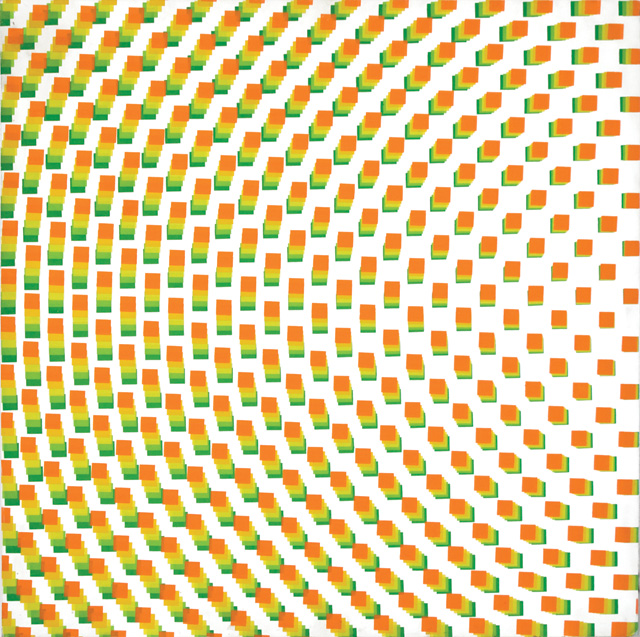
François Morellet. Du vert à l’orange (5 passes de carrés réguliers pivotées sur le côté), 1971. Silkscreen ink on wood, 80 x 80 cm. Courtesy The Mayor Gallery, London.
ARC: Part of your activity as a founder of GRAV was the organisation of the Journées dans la rue [Street days], designed to engage the active participation of the spectator, one of the central tenets of the group. You’ve said that this audience engagement was pushed very far. A charming programme of one of these happenings gives a flavour of their playful quality, but can you elaborate on how passersby responded, as the nature of these ephemeral events is much harder to preserve than a concrete artwork? Who exactly were these spectators?
FM: The spectators of these Journées dans la rue reacted like anyone else who happened to be passing by. Those in a hurry would rush by with indifference, others would stop for a few moments, taken aback by this circus, while a minority would take the time to play with our ridiculous bricolages. In any case, it was an opportunity for a good laugh.
ARC: GRAV put an end to these happenings in May 1968 when you met with the competition of the May Events. Did the kind of neo-Dada works you were staging seem frivolous in comparison with general strikes, factory and university occupations, and rioting? Or were there connections?
FM: My personal point of view is that art is frivolous even when it takes itself seriously and that May 68 was more like a great celebratory happening than the October 1917 revolution in Russia.
ARC: You insist on humour as an important, perhaps even didactic, value – you’ve been called a “rigorous joker” [rigoureux rigolard] and were interested in figures such as Duchamp and Picabia, for whom an almost schoolboyish irreverence was crucial. But it seems hard to accommodate genuine humour in the false high seriousness of the art world. If anything, the provocative gestures of figures such as Duchamp and Manzoni seemed to have generated ever more pretentious criticism. Why do you think this is?
FM: My parents were quite sociable, their company and their dinner table much appreciated. One day, a Swiss-German guest slowly declaimed: “Monsieur Morellet, how I admire you! The effort you put into being humorous for your guests.”
As was the case for my father, being serious requires a lot of effort for me, even if, as my longstanding German gallery reminded me: “With the prices your works fetch, you should be more arrogant.”
I’m obviously aware of the fact that my taste for the absurd is detrimental to my being taken seriously in the art world, or the world in general, but my doctors advise me to avoid any strain.
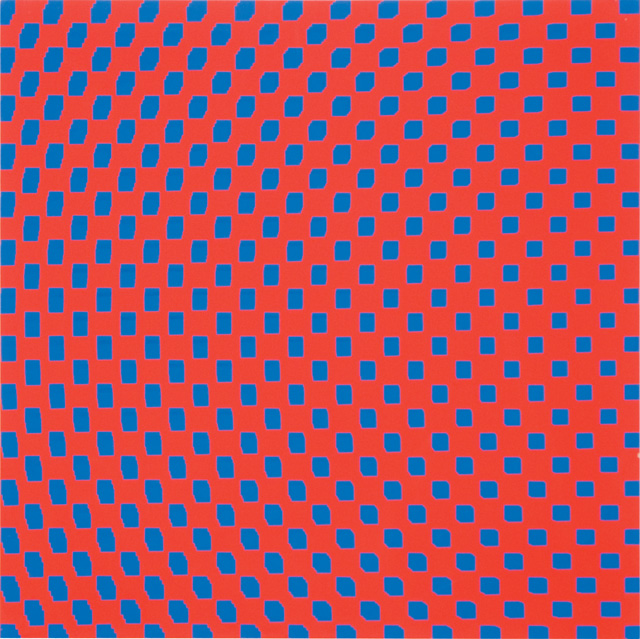
François Morellet. 3 Trames de carrés réguliers pivotés sur le côté, 1970. Silkscreen on wood, 23 5/8 x 23 5/8 in. Courtesy The Mayor Gallery, London.
ARC: You also seem very interested in language, having incorporated homophonic puns, palindromes and other wordplay in the works themselves or their titles. Some of these, such as Free Vol, are even translinguistic, like Charles Aznavour’s song For me Formidable. But you have also produced many texts on your work, collected in your wonderfully titled anthology, Mais comment taire mes commentaires, and you covered an early work, Sculpture à lire, in text. What appeals to you about language? Is it the fact that it’s system based – I think the self-imposed constraints of Oulipo interested you – or do you simply like the fact that you can use it to make jokes?
FM: I was a keen reader of Raymond Queneau and Georges Perec, I still have the first edition ofQueneau’s Hundred Thousand Billion Poems in which each verse is printed on a strip of paper that is interchangeable in as many combinations as the title states. Perec’s 300-page novel without the letter ‘e’, A Void, together with Les Revenentes, written with no other vowel but ‘e’, and his palindrome, a world record of 1,247 words, are feats of staggering literary prowess as far as I’m concerned.
My demanding work as a provincial industrialist unfortunately ruled out interesting encounters, bearing in mind that one of the characters of Perec’s last book, Life: A User’s Manual, is called Morellet.
If I were a dictator, I would pass a law banning all uses of language other than for the purpose of making jokes.
ARC: You often engage with old master painting and its institutions, for example in your d’Après and Défigurationsseries, in which you respond to works by artists such as Delacroix, de la Tour, Poussin and Watteau. You even produced a response to Monet’s Cathedrals using neon and designed stained-glass windows in your L’esprit d’escalier permanent installation in one of the “holiest” of artistic institutions, the Louvre. In these cases you’re both spectator and producer: what do these works or settings give you and how does their “aura” fit in with your systematic, rational way of producing art?
FM: In my fight against subjective decisions, I’ve often used an effective technique, which is to create works with other artists such as the members of GRAV and, amongst others, Spoerri, Lavier, Verjux, Dietman, Armleder, de Vries, Yoko Ono … But also dialogues that are either disrespectful or complicit with masterpieces chosen from the museum collection where I’m invited to exhibit. My 140 Architectural Disintegrations follows the same principle, a confrontation between my systems and architecture. My lines break the architecture, the architecture breaks my lines – it’s a fair fight.
Otherwise, I’ve always tried to combat the overestimation, sacralisation, pretention, esotericism, transcendence and high seriousness of certain artists and sites. So it’s with a celebratory detachment that I watch my systems connect, often foolishly, with a space, an architecture, or a masterpiece.
ARC: You’ve always sought to reduce subjectivity, gesture and choice in your work, preferring to use systems that minimise these, for example juxtaposition, interference, randomisation and destabilisation. One work reproduced odd and even numbers “randomly” selected from your local telephone directory. But these systems are conceived by you, and involve a series of choices, whether it’s which phone directory to use or how many numbers to include. Ultimately, surely your intervention and even your personality can’t be eradicated from your works, particularly in view of the fact that you’ve managed to renew similar series of elements over such a long period of time? Even geometry can have a magical, enigmatic quality, for all its apparent rationality.
FM: Only Duchamp pushed to an extreme the separation between the artist and his work, with his final work reduced to a sole subjective decision, which was not to produce anything any more.
For the past 60 years I’ve produced useless objects, characterised by the absence of any interest in composition or execution, using simple systems and often appealing to chance. If, despite that, you see an enigmatic or magical aspect, it is probably the case that my discourse is not sufficiently clear or, more likely, that you are part of that category of brilliant spectators who, in order to unpack their poetic-philosophical picnic, need empty place settings prepared for that purpose.
ARC: Your essay Du spectateur au spectateur ou l’art de déballer son pique-nique [From spectator to spectator or the art of unpacking a picnic] humorously but accurately identifies some of the necessary prerequisites for art, at least according to official accounts: seriousness, repetition, deathand age, factors that can transform the slightest thing into art. At the same time, you scorn the attitude adopted by certain artists that normal activities from other spheres of life, when adopted by artists, become, in their view “special”, or art. Do you reject the idea that there is some special category of object, activity or space that doesn’t belong to any other category and that therefore can only be defined as art?
FM: Yes, I reject this idea and I note, year after year, with the offerings of new generations of artists, that the expansion of the domain set aside for art pushes its own limits further and further away.
• An exhibition of the work of François Morellet, Les règles du jeu is at the Mayor Gallery, London, until 27 May 2016. A further exhibition, François Morellet: 90, is at Annely Juda Fine Art, London, until 24 June 2016.